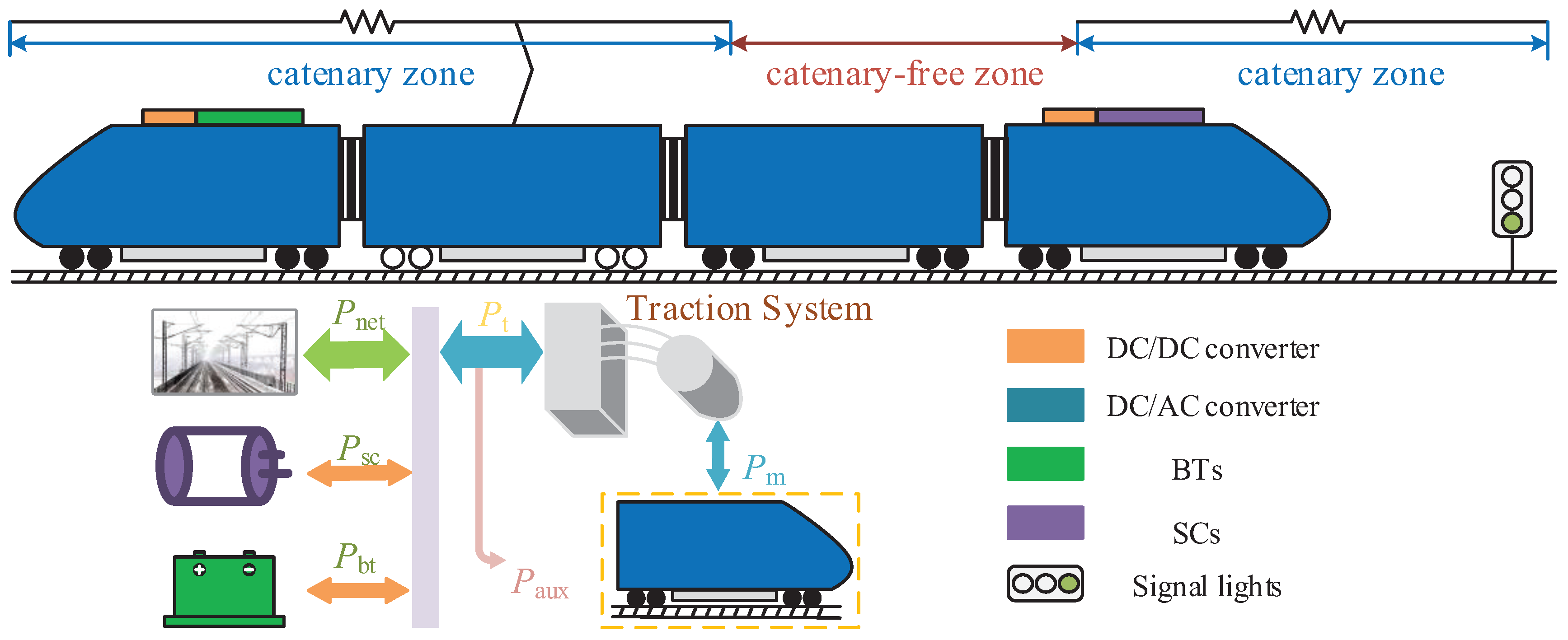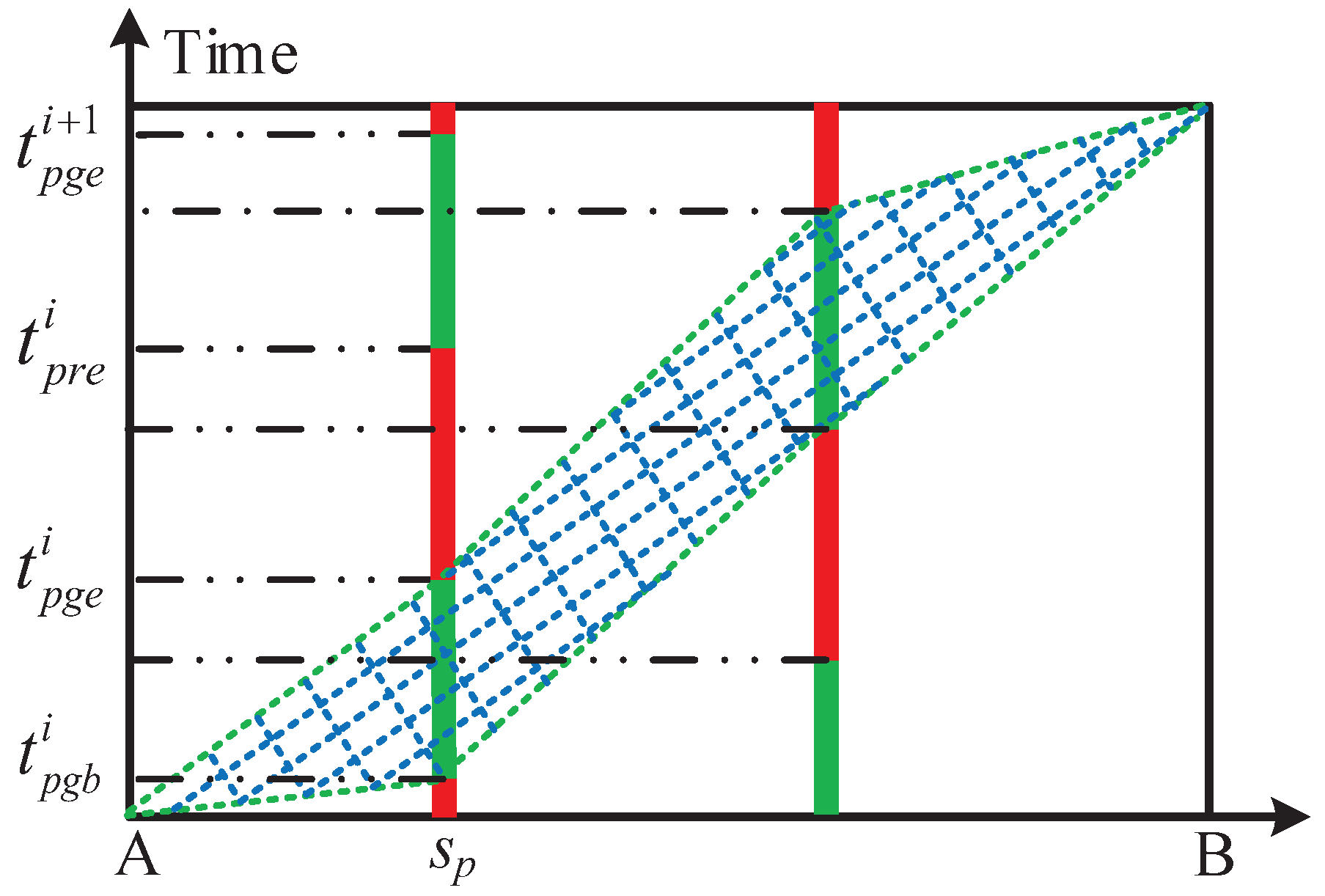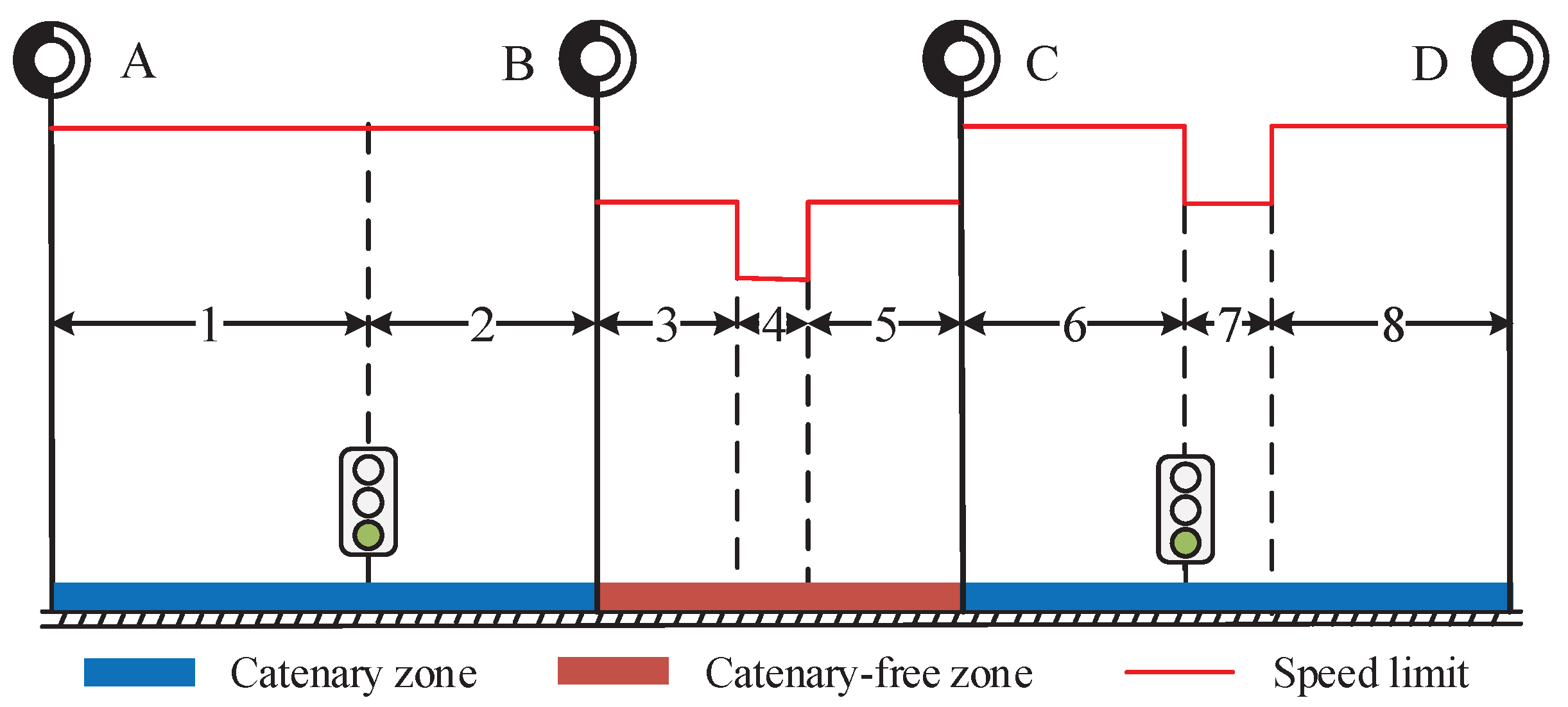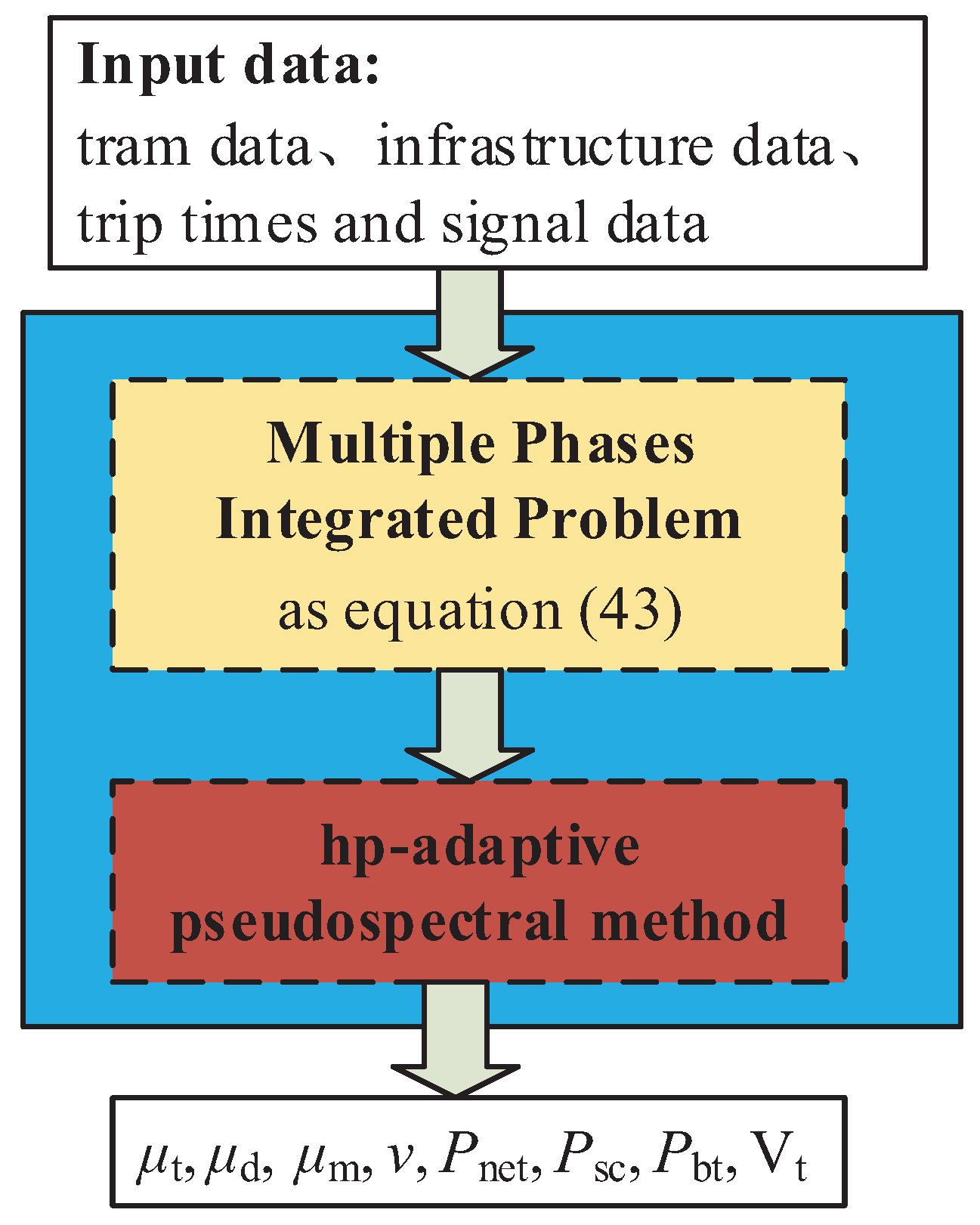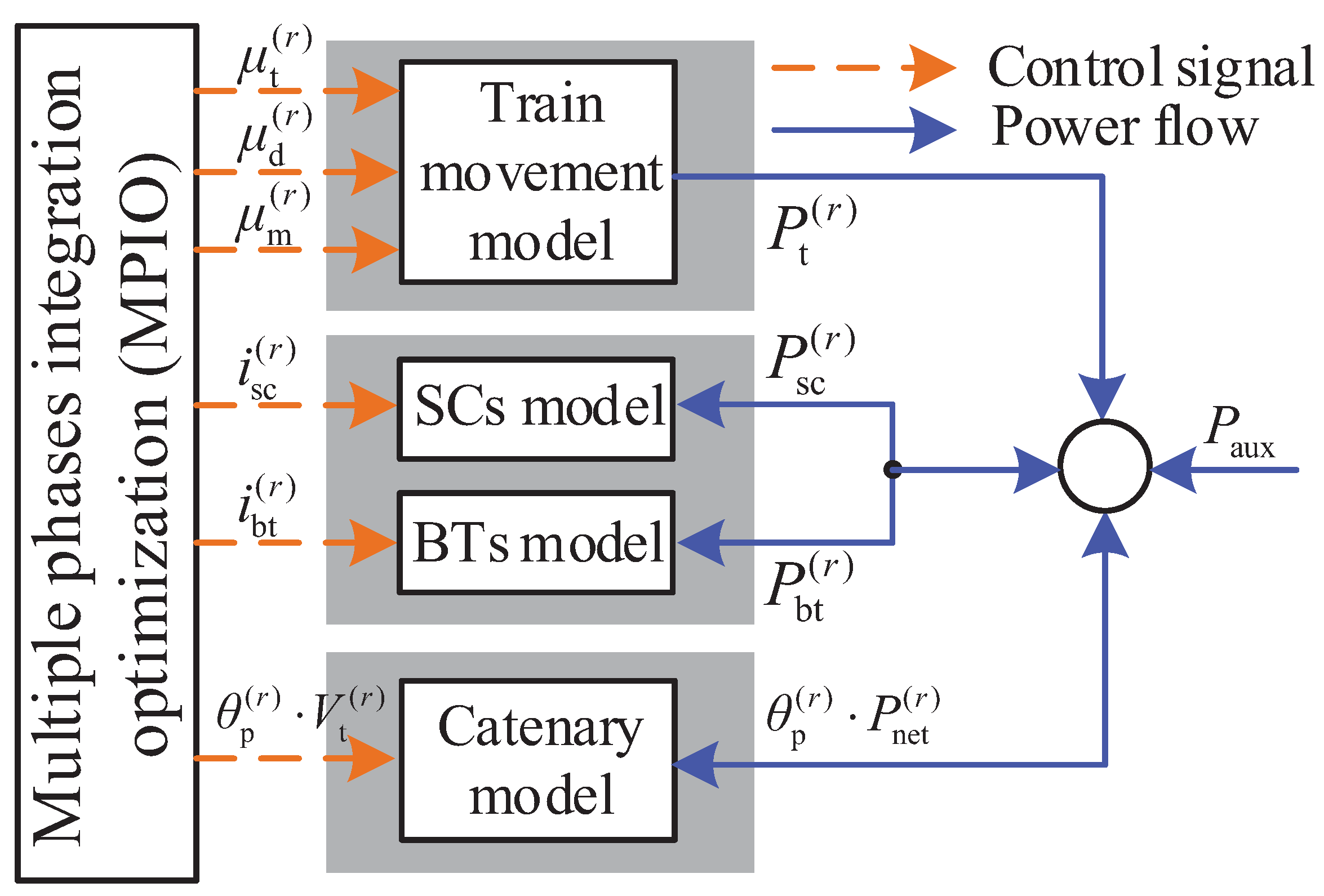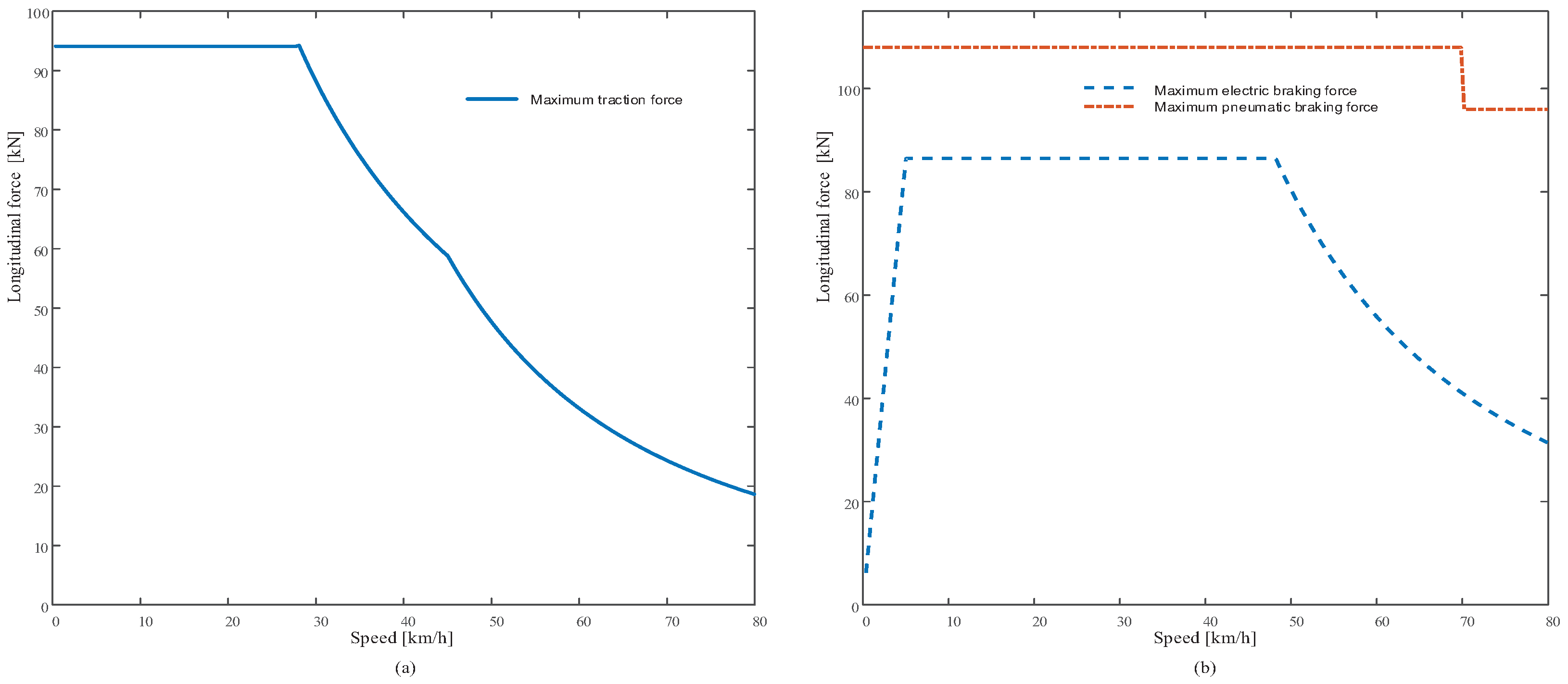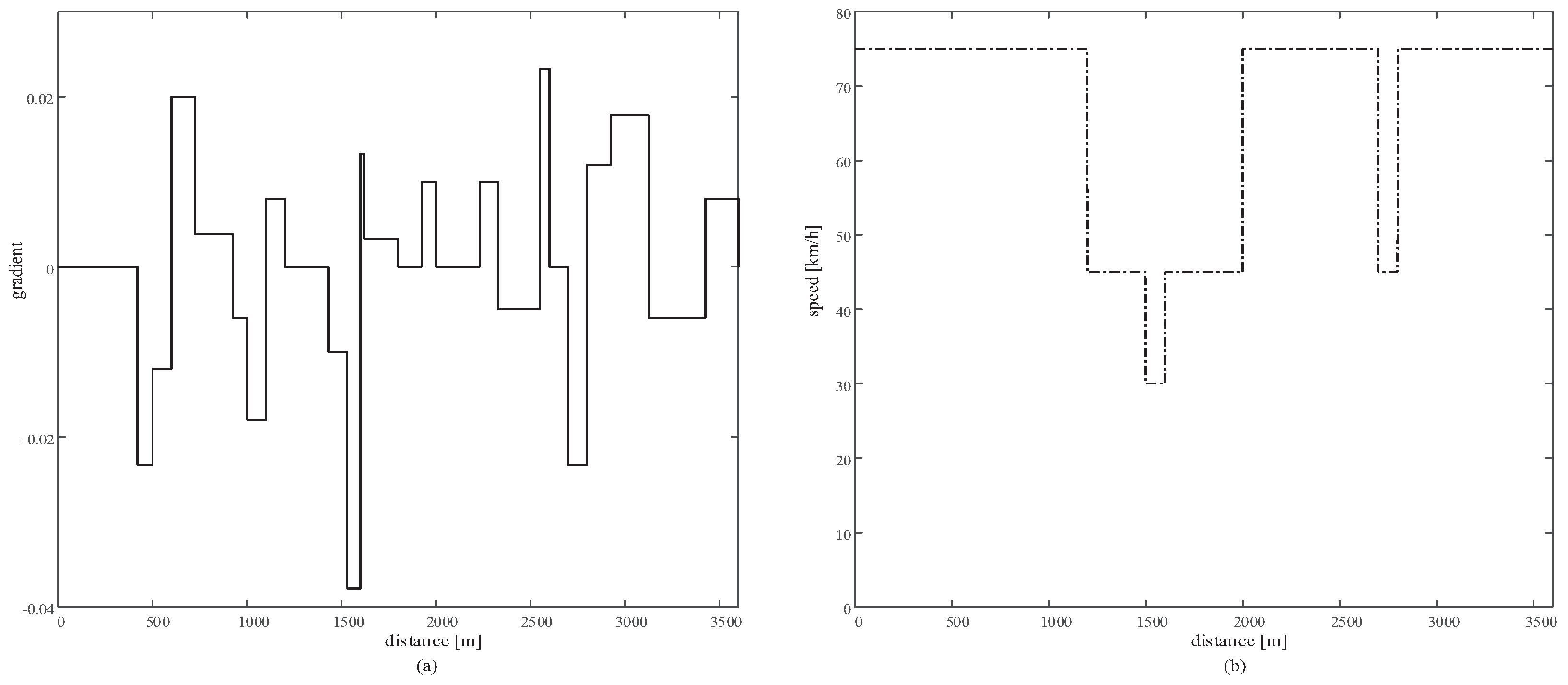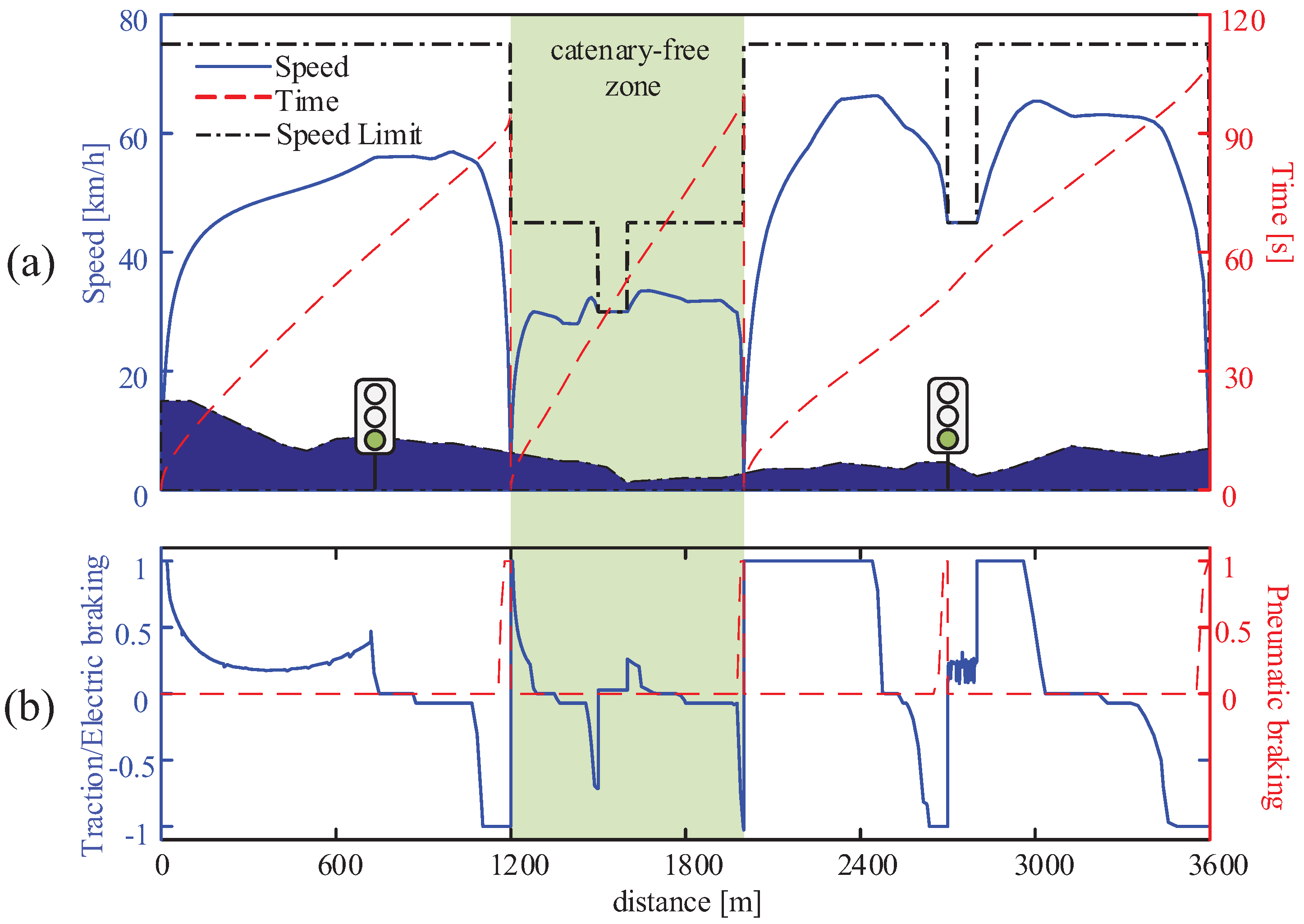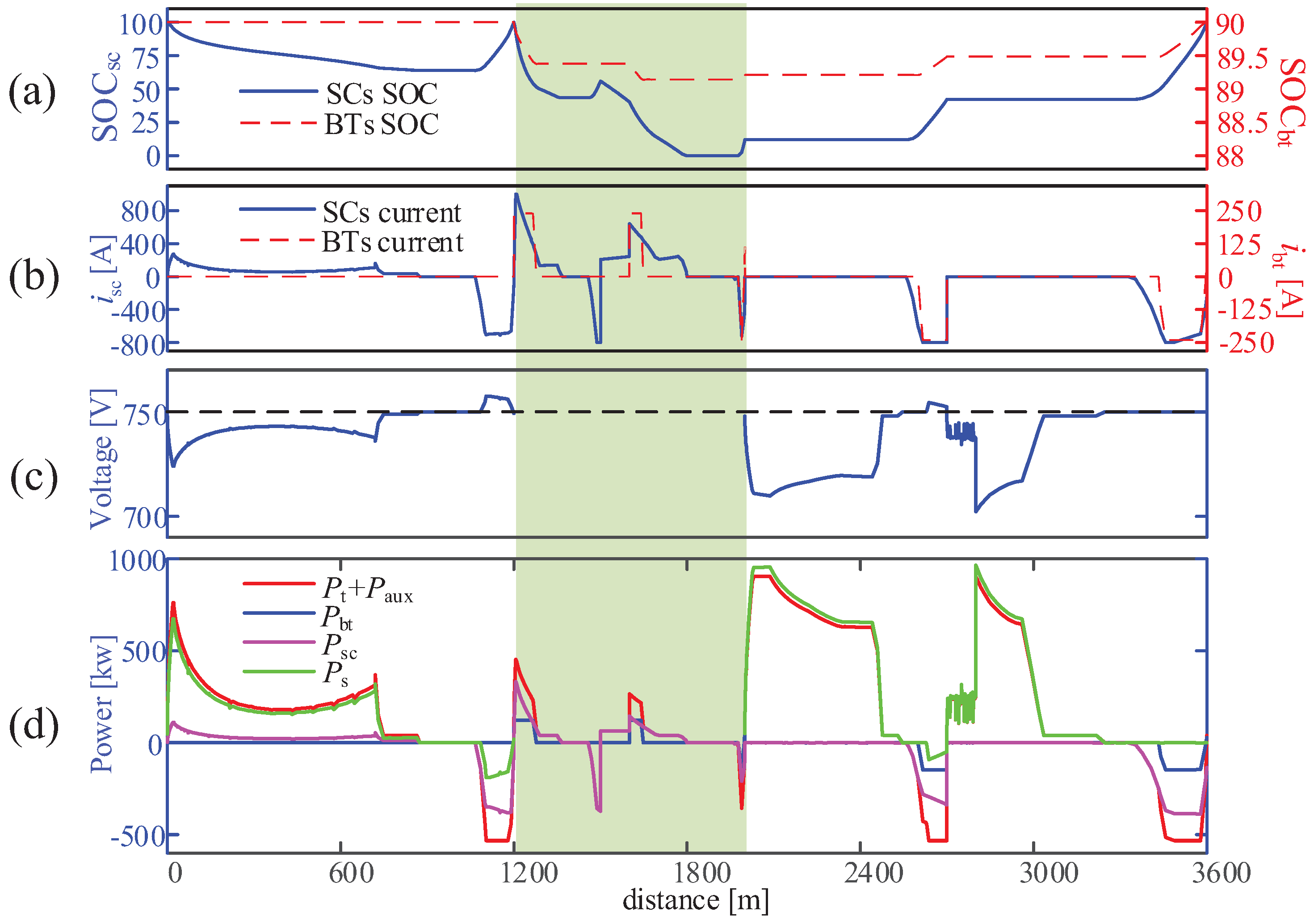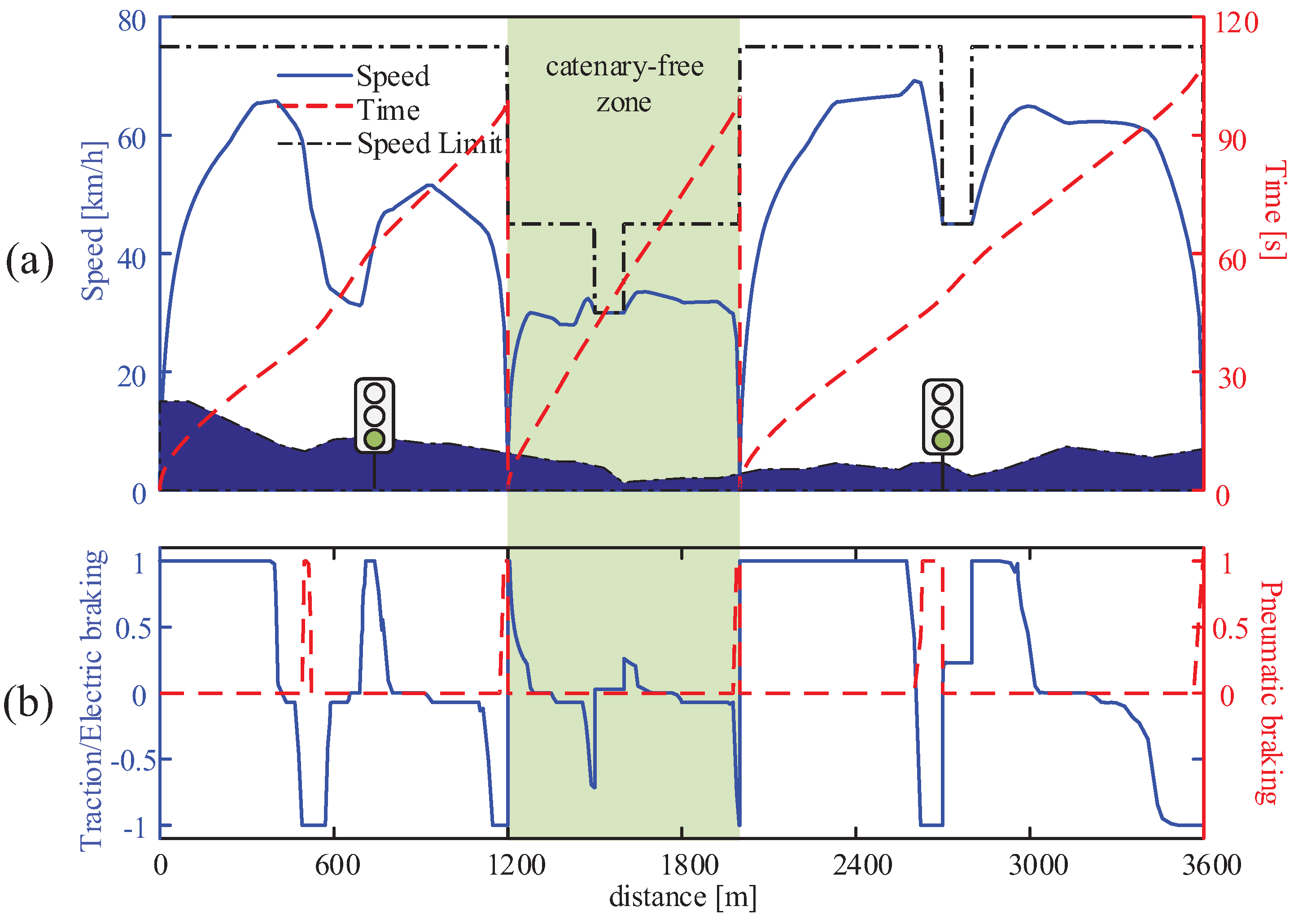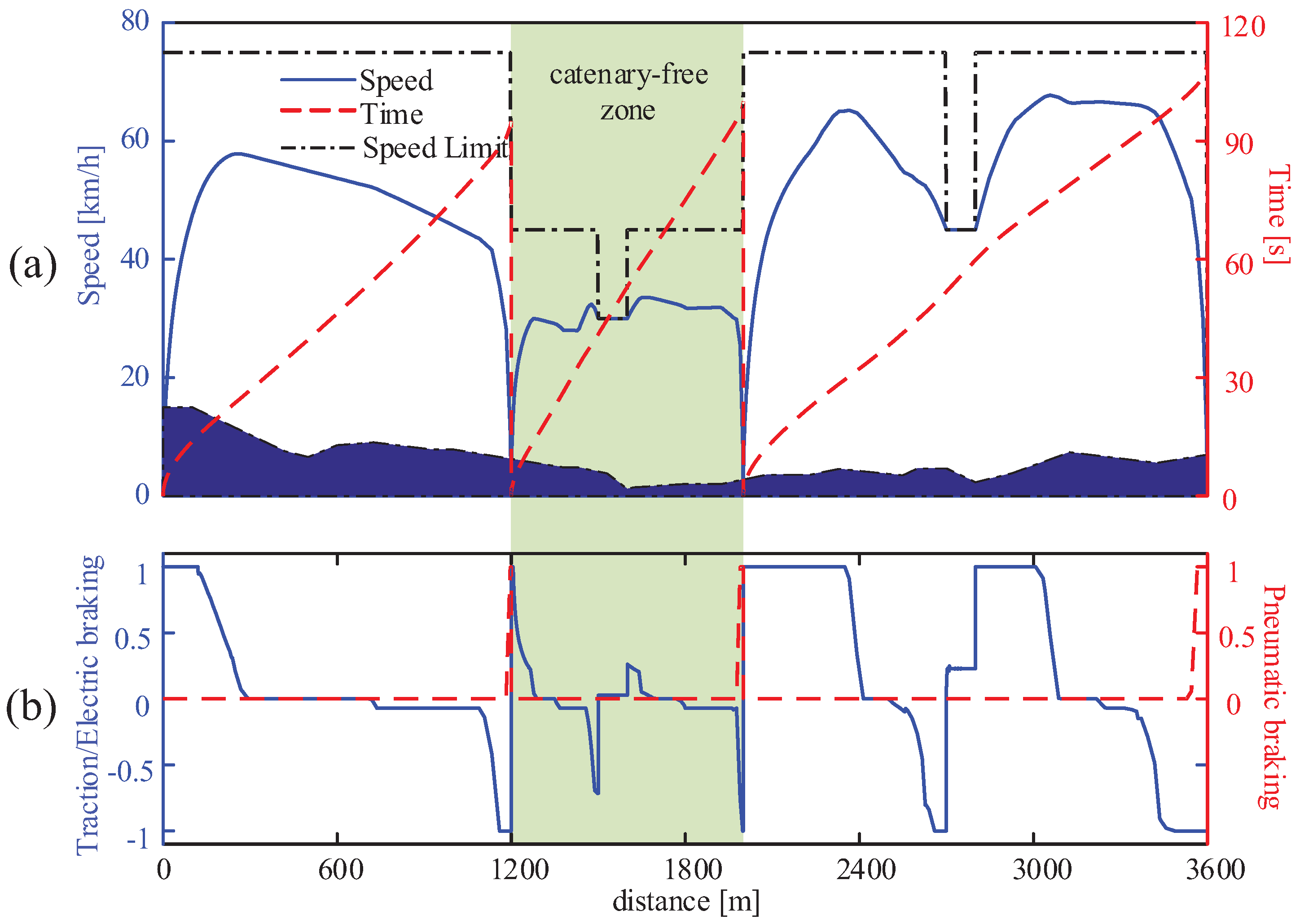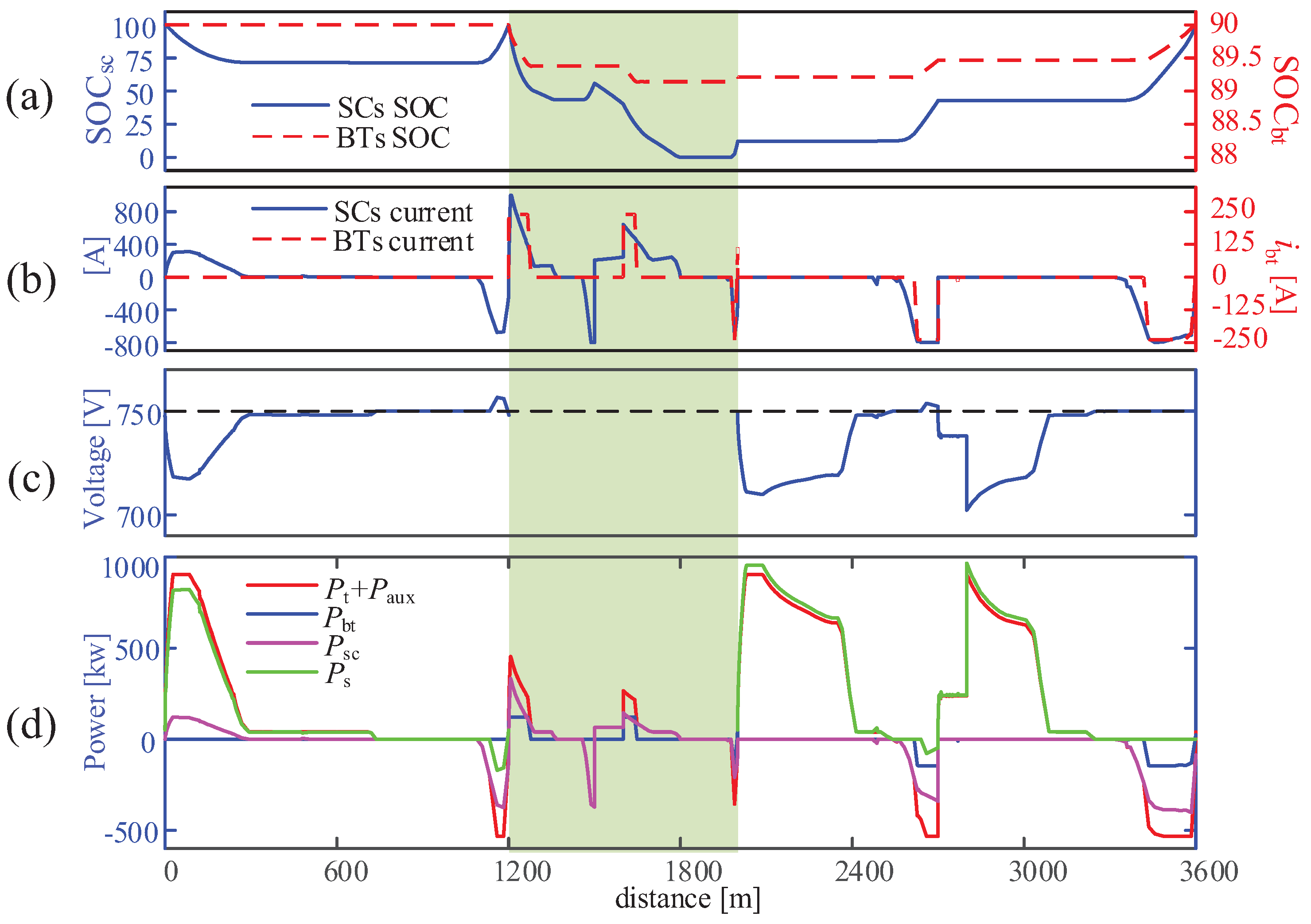1. Introduction
Trams have been one of the most popular urban rail transit vehicles in the past few years due to the economic and environmental advantages. There are some routes including both catenary zones and catenary-free zones, because some sections that are not suitable for setting up catenary in business centers or the tourist attraction. A tram with on-board energy storage systems (ESSs) can drive autonomy in the catenary-free zones [
1]. For the tram with on-board ESSs, a method is called to improve the energy efficiency of the overall system. Apart from energy-efficient design of vehicles, eco-driving and the utilization of regenerative braking energy are recognized as the most promising methods [
2]. Eco-driving refers to the optimization of driving strategies, which can reduce the energy consumption and ensure the punctuality of trips. The utilization of regenerative braking energy can be realized by on-board ESSs, according to properly conserving the electric braking energy and delivering power for the next traction operation [
3]. The coordinate optimization of the two problems can increase the energy efficiency and enhance the performance of the tram. Hence, the research focuses on the integrated optimization of speed profiles and power split for a tram with on-board ESSs.
Former studies for speed profiles were based on trains with a single power source, either electric power or fossil fuel. Their purpose is to calculate the optimized speed profiles under fixed time and operation constraints. The solution methods can be classified into indirect methods and direct methods. Indirect methods are based on the conclusions of Pontryagin maximum principle (PMP). The optimal shape of single train speed profiles optimization problem is obtained in [
4], which consists of Maximum Power, Cruising, Coasting and Maximum braking. In order to get the optimal speed profiles, Liu et al. [
5] discussed the optimal switching condition based on PMP. The calculation method of local optimal switching points is studied by Howlett [
6]. Wang et al. [
7] summarized the optimal switching rules of optimal modes considering regenerative braking, and a global linkage algorithm was proposed with different gradients and speed limits. Direct methods can optimize speed profiles without any pre-defined knowledge. Typically, mathematical programming algorithms, such as mixed-integer linear programming (MILP) [
8], sequential quadratic programming (SQP) [
9] and evolutionary methods [
10,
11], are used to calculate speed profiles directly based on the optimization model. Lu et al. [
12] compared the results of single train trajectory optimization by ant colony optimization (ACO) algorithm, genetic algorithm (GA) and dynamic programming (DP).
Traffic management, at intersections, is realized by signal lights, which is controlled by a signal controller. FTS and TPS [
13] are two typically signal control strategies in the tram systems. TPS refers that the signal time should be adjusted to guarantee the tram to pass intersections without any influence. FTS means that the cycle of signal time is constant, and the tram has to stop before the stop-line if the signal light is red, which may lead to the increase in operation time and energy consumption. To solve this problem, signaling influence is considered as a time constraint in [
14,
15], and green wave can be realized to avoid idling. Haahr [
16] used DP to deal with the constraints of intermediate passage points, and the energy consumption can be decreased. However, the utilization of regenerative braking energy is not considered in the studies.
The main challenges of using the regenerative braking energy lie in the power split strategies of different power sources. The conditions of power supply are different in catenary zones and catenary-free zones. In catenary zones, the power sources contain the traction substation and on-board ESSs. For the irreversible substation, regenerative energy cannot be absorbed if there are no accelerating vehicles in the same segment of traction power supply. Meanwhile, the voltage of the catenary would rise and damage the system infrastructure potentially [
17]. In catenary-free zones, the tram is only powered by on-board ESSs. Hence, the type of ESSs plays an important role to enhance performance of the tram. Presently, batteries (BTs) and supercapacitors (SCs) [
18,
19] are widely used in transportation regions for on-board ESSs. The BTs have high energy density but a low power density, and the characters limit their standalone application in trams. The SCs can provide high power density and fast response but low energy capacity. Hence, hybrid energy storage systems (HESSs) combined the BTs with the SCs can improve the operation performance of the tram [
20,
21].
Energy management strategies are proposed to achieve minimum cost of the multi-sources system. The approaches can be grouped into two main categories: optimization-based and rule-based. The theoretical optimal power sharing results can be obtained by global optimization algorithms such as DP [
22] or GA [
23]. Li et al. [
24] proposed a state machine strategy based on droop control to coordinate multiple power sources. However, the drive cycle has known in advance. Shen et al. [
25] presented an intelligent online algorithm to optimize the power split of HESSs based on neural networks. The rules of Rule-based methods are derived from optimal control theory and human experience [
26], without a priori knowledge or a reference speed curve. The overall efficiency of the system would be influenced and suboptimal results might be obtained.
In the above studies, the optimization of speed profiles and power split for the tram with HESSs are studied separately. However, speed curves and power split interact with each other based on the power flow of the system. The coordination of speed profiles and the charging/discharging control instructions simultaneously is considered in [
27]. Besides, speed limitations, gradients and signaling constraints are not considered, and the SCs are the only ESSs. The results of a catenary zone are discussed. It is a significant challenge to improve the energy efficiency of the tram with on-board HESSs. In this paper, a multiple phases integrated optimization model is established to coordinate operational constraints of the tram, the signaling, traction power supply system (TPSS), optimal running states connection between catenary zones and catenary-free zones, and the MPIO method is verified under two different signal control strategies: TPS and FTS.
To conclude, the contributions of this paper are given as follows. Firstly, a multiple phases integrated optimization model for coordination of speed profiles and power split of multiple power sources has been established. The variable gradients, speed limits, timetable, signal timing and the character of TPSS are considered. Secondly, a simulation framework, using hp-adaptive pseudospectral [
28] approach, is introduced to solve the integrated optimization problem. Thirdly, two signal control strategies are discussed to verify the efficiency of the MPIO method. The simulation results indicate the energy saving potential of the method.
The rest of this paper is organized as follows.
Section 2 presents the system models of the hybrid tram and two different signal control strategies. In
Section 3, the multiple phases optimization model and the calculation framework are developed to solve the energy efficiency problem. In
Section 4, several case studies are evaluated. Conclusions are given in
Section 5.
